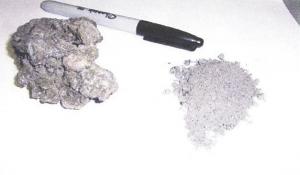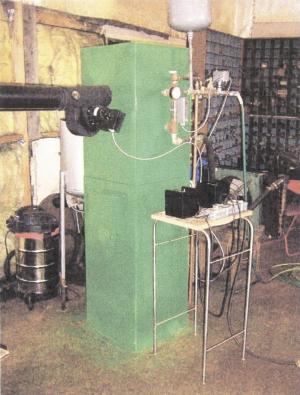2009 - Volume #33, Issue #6, Page #26
[ Sample Stories From This Issue | List of All Stories In This Issue | Print this story
| Read this issue]
Hot Water Furnace Burns Hay Pellets
 |
 |
Because when hay burns at high temps the ashes fuse into clinkers. The clinkers quickly build up in the firepot and can smother the fire in only a few hours. You have to clean the firepot too often to be practical.
Gus Swanson says his new hay pellet burning stove and hot water boiler will solve the problem. The multi-purpose furnace burns hay and wood pellets as well as corn.
The stove's key feature is a patent pending ash remover, which reduces naturally forming clinkers into a fine powder ash. The ash removal system works automatically and continuously during the burning process. It consists of a rotating bar with built-in flutes that stirs the clinkers and pushes them to the outside of the firepot, where they break down into fine ashes. An auger then automatically dumps them into a 5-gal. pail.
Swanson's company, LST Energy, has been working with Cornell University. His test model burns 4 lbs. of hay pellets per hour and has an output of 40,000 btu's. Wood pellet making companies in Canada made the hay pellets that they used in their tests.
"It's a clean burning system that's virtually maintenance-free," says Swanson. "The fire isn't disturbed and there is complete combustion of all pellets. The operator never has to touch the ash."
According to Swanson, heating a building with hay pellets costs about half as much as oil.
"Last winter I used the furnace to heat a 3-unit apartment building and used 4 lbs. of hay pellets per day, at a cost of about $300 per month. I had been heating with oil at a cost of about $700 per month.
"We use another hay pellet hot water furnace to heat our shop every day and will test two more stoves in farm greenhouses this fall. And this winter the Department of Agriculture in Truro, Nova Scotia, will test one of our furnaces. "
He says hay pellets have an ash content about 10 times as high as wood pellets.
More than trying to build a business, Swanson says he's trying to build an industry across North America and boost the market for hay. "Our ultimate goal is to make hay pellets and deliver them by truck to the homeowner. At the time of delivery, the truck will pick up the ashes which the homeowner has stored in a bin and haul them away. The homeowner won't have to handle ashes if they don't want to.
"We think the same idea might work with straw pellets made from wheat, oats or barley or even weeds, although we haven't done any tests on those materials yet. The key is to get the moisture content down to 13 percent."
Contact: FARM SHOW Followup, LST Energy Inc., 357 Haliburton Rd., P.O. Box 760, Pictou, Nova Scotia, Canada B0K 1H0 (ph 902 485-9348 or 902 485-8509; gswanson@lst-energy.com).

Click here to download page story appeared in.

Click here to read entire issue
To read the rest of this story, download this issue below or click here to register with your account number.




